Abstract
Visual evoked potential recordings were examined in 45 liver cirrhosis patients with (n = 29) and without (n = 16) encephalopathy, in 15 normal volunteers, and in one patient with an opioid induced stupor state. Visual evoked potential parameters were classified on the basis of EEG recordings. Plasma concentrations of amino acids, octopamine, and ammonia were assayed in order to document the metabolic change of hepatic encephalopathy. Latencies and wave patterns recorded after flash stimulation differentiated the four degrees of the coma one from another according to EEG classification in the 29 patients with encephalopathy. In the group of 16 patients without clinical and EEG evidence of encephalopathy the visual potential recordings discriminated a group of patients (n = 10) in a preclinical stage of encephalopathy. Biochemical parameters and subsequent clinical observation of patients confirmed our judgement of a preclinical stage of encephalopathy. These results suggest that visual evoked potentials are a simple, suitable and objective method for differentiating the degrees of encephalopathy and for identifying the preclinical stage of encephalopathy.
Full text
PDF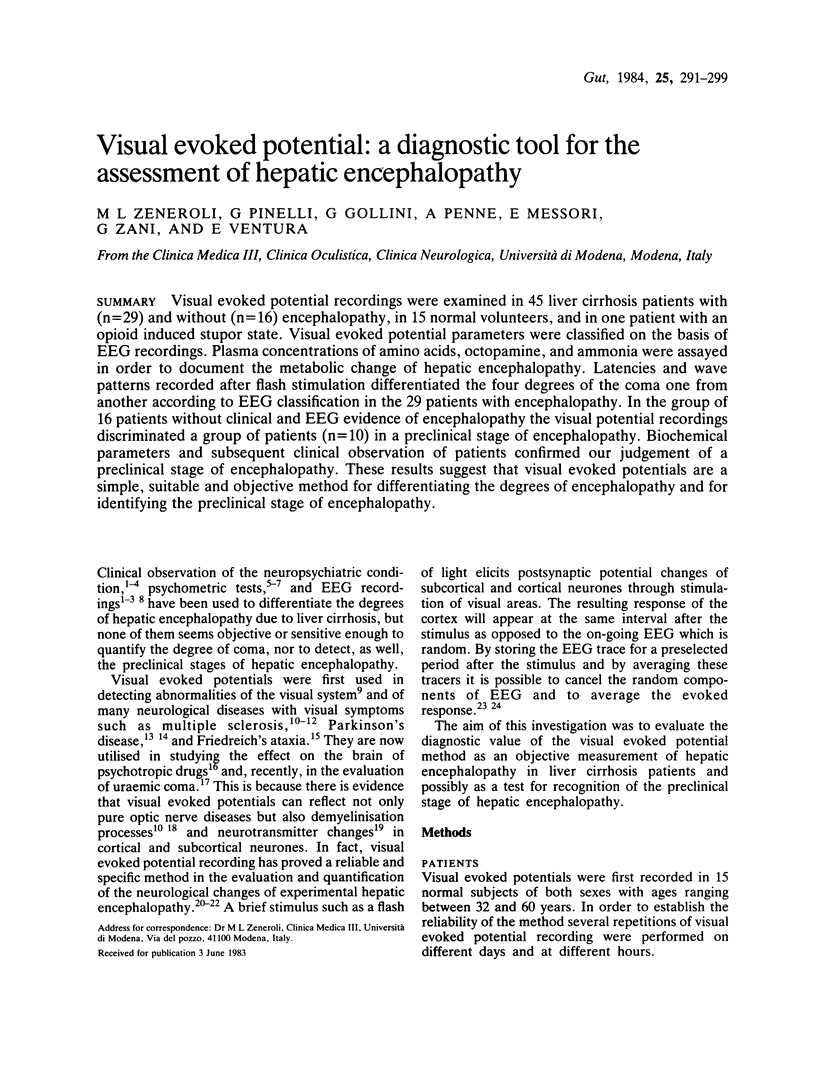
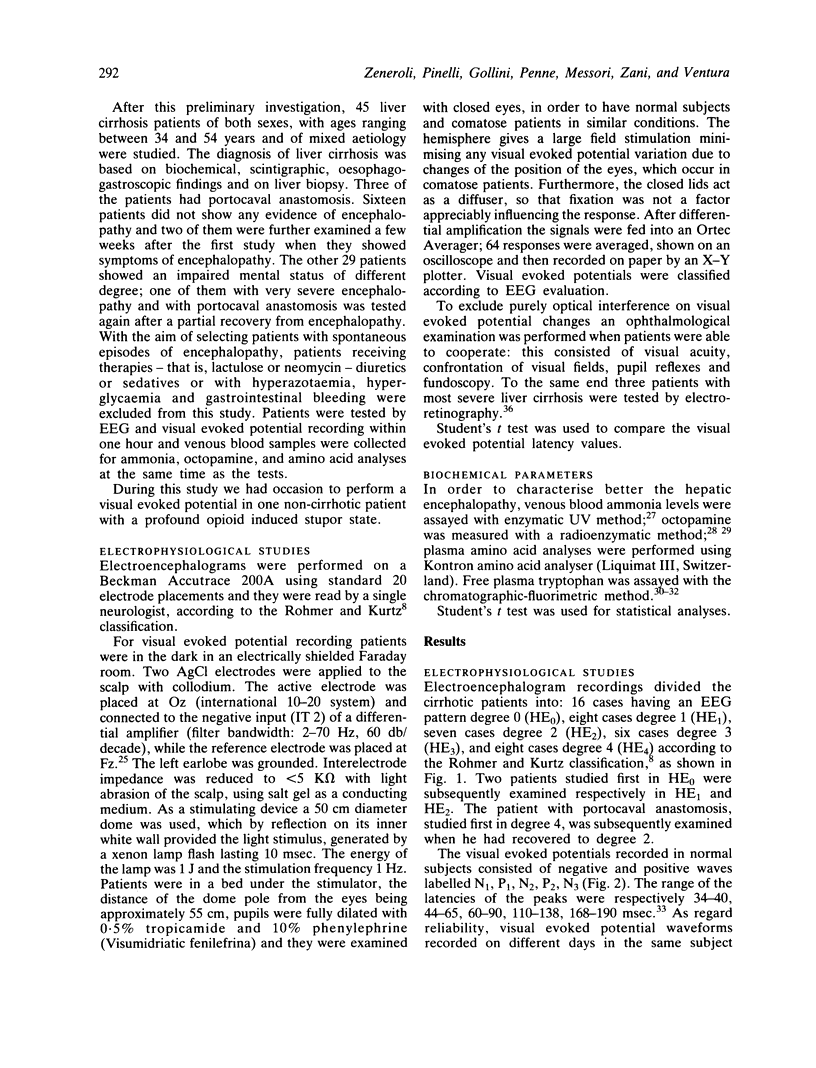
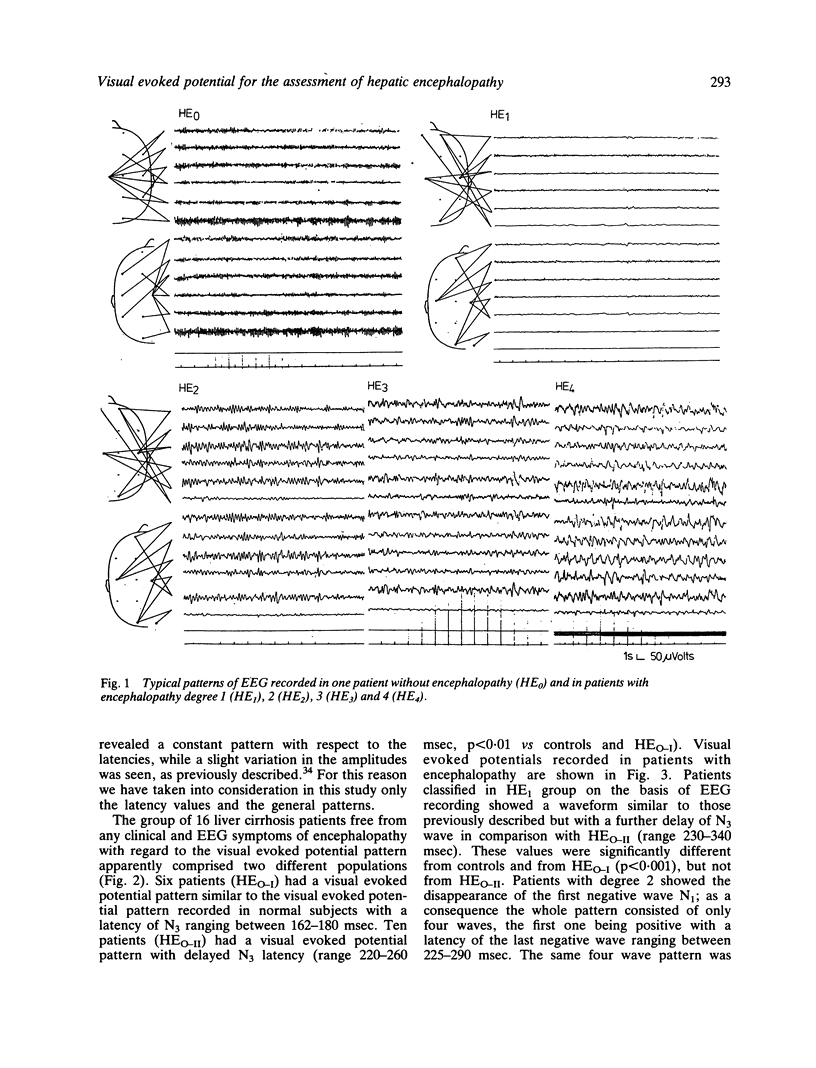
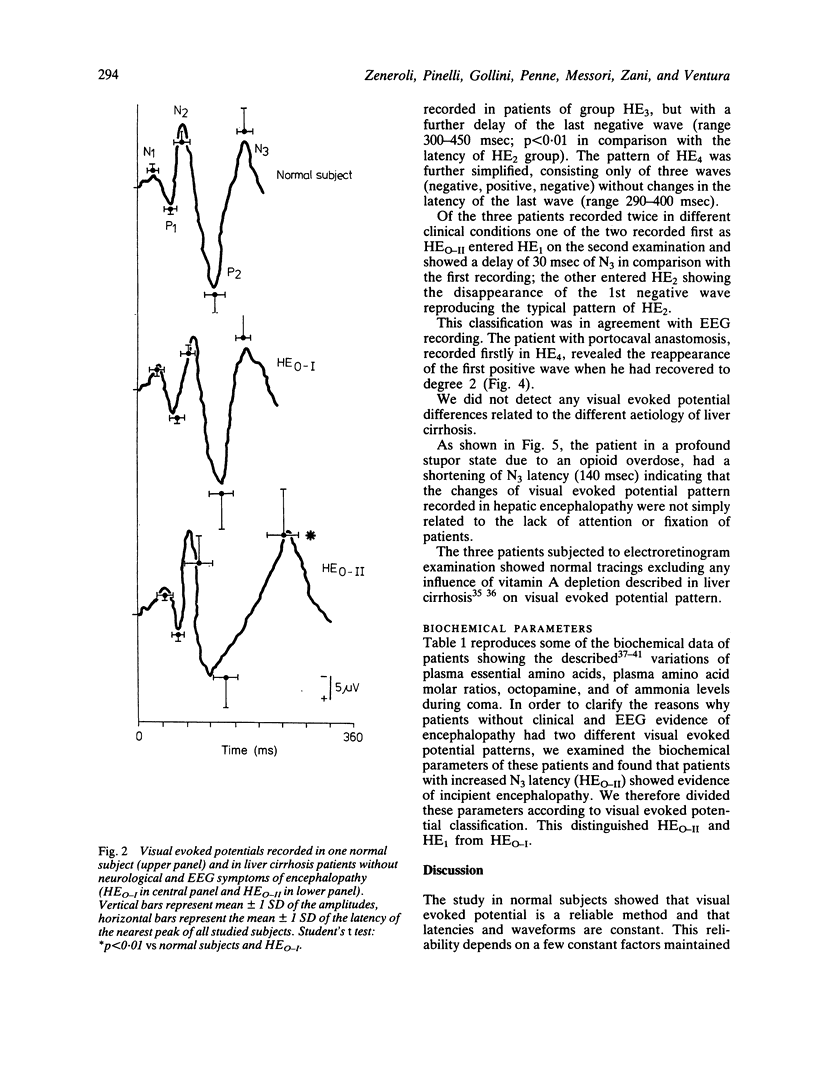
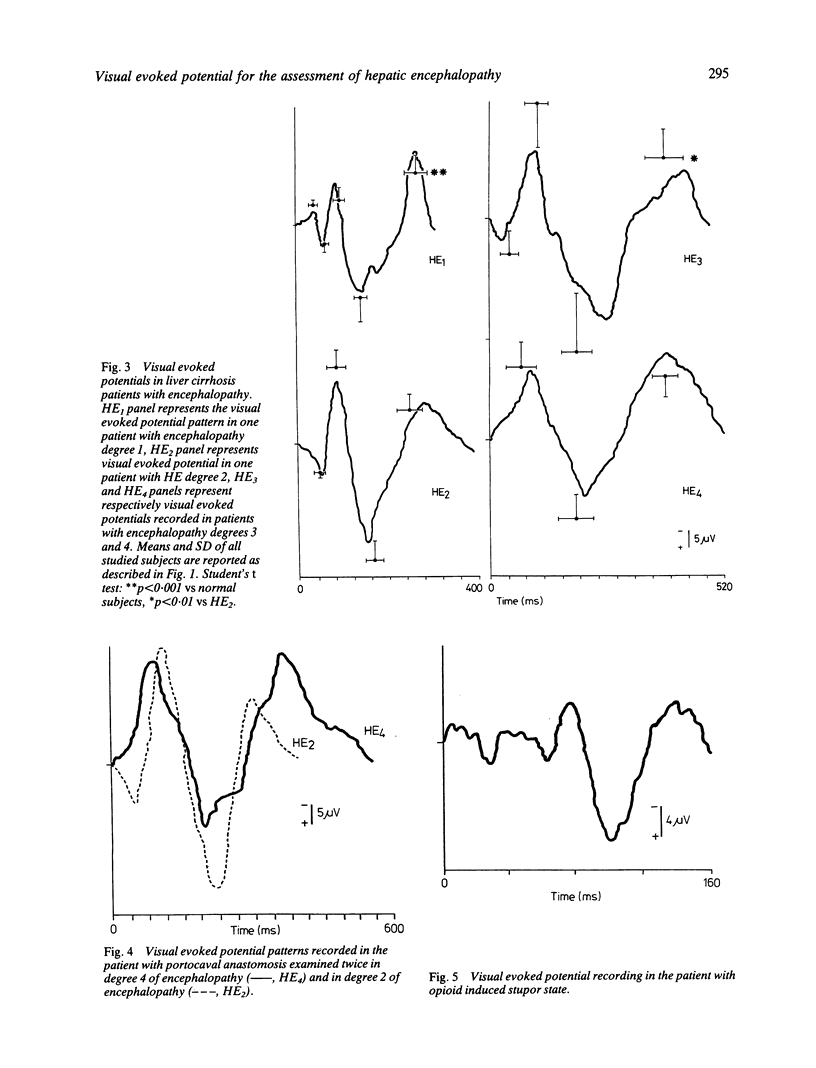
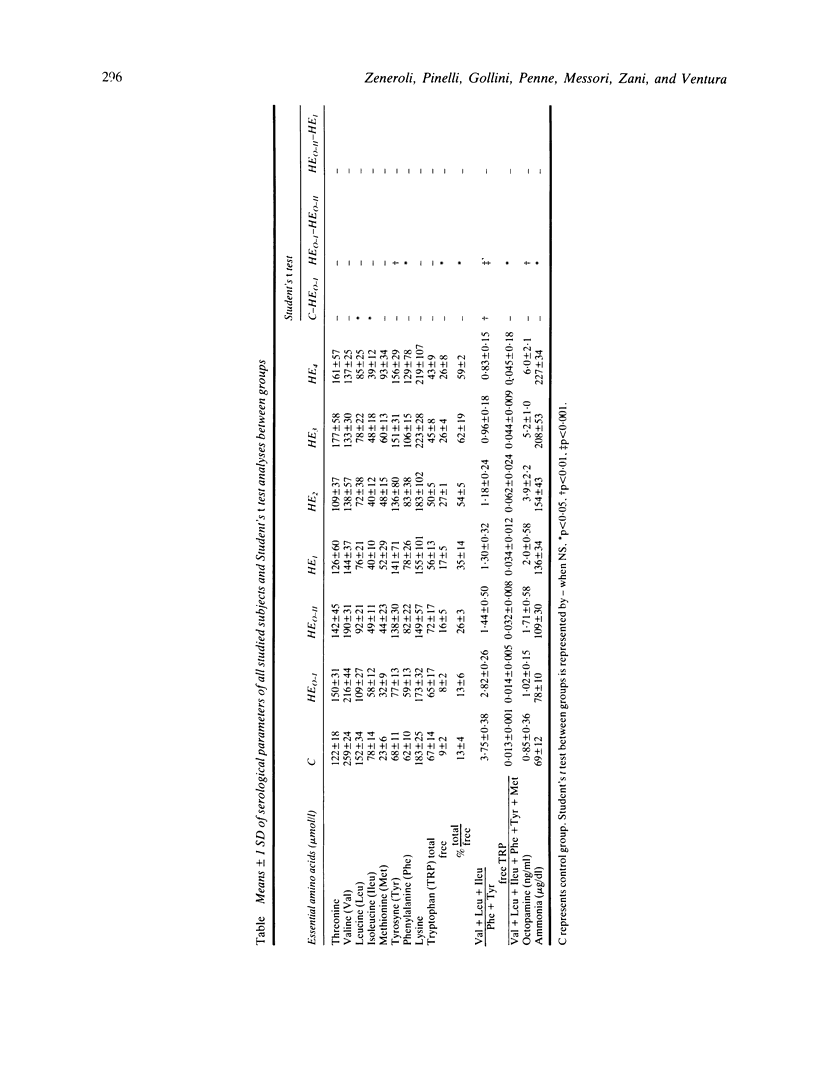
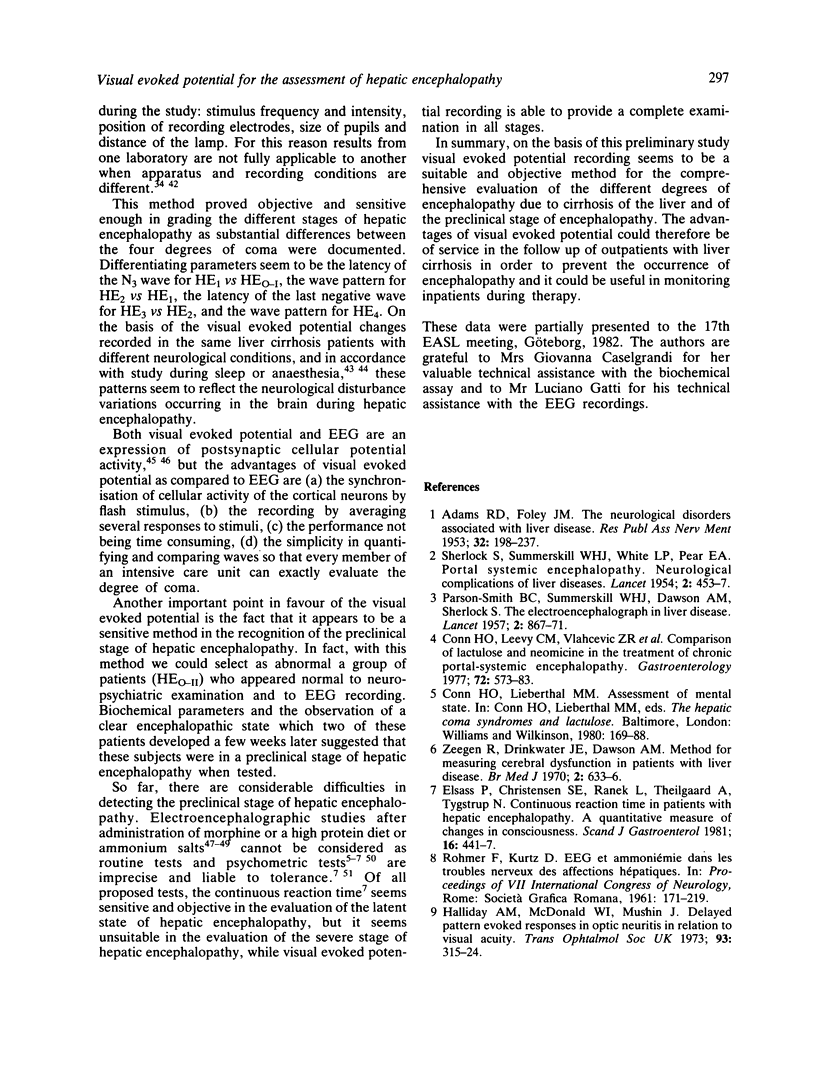

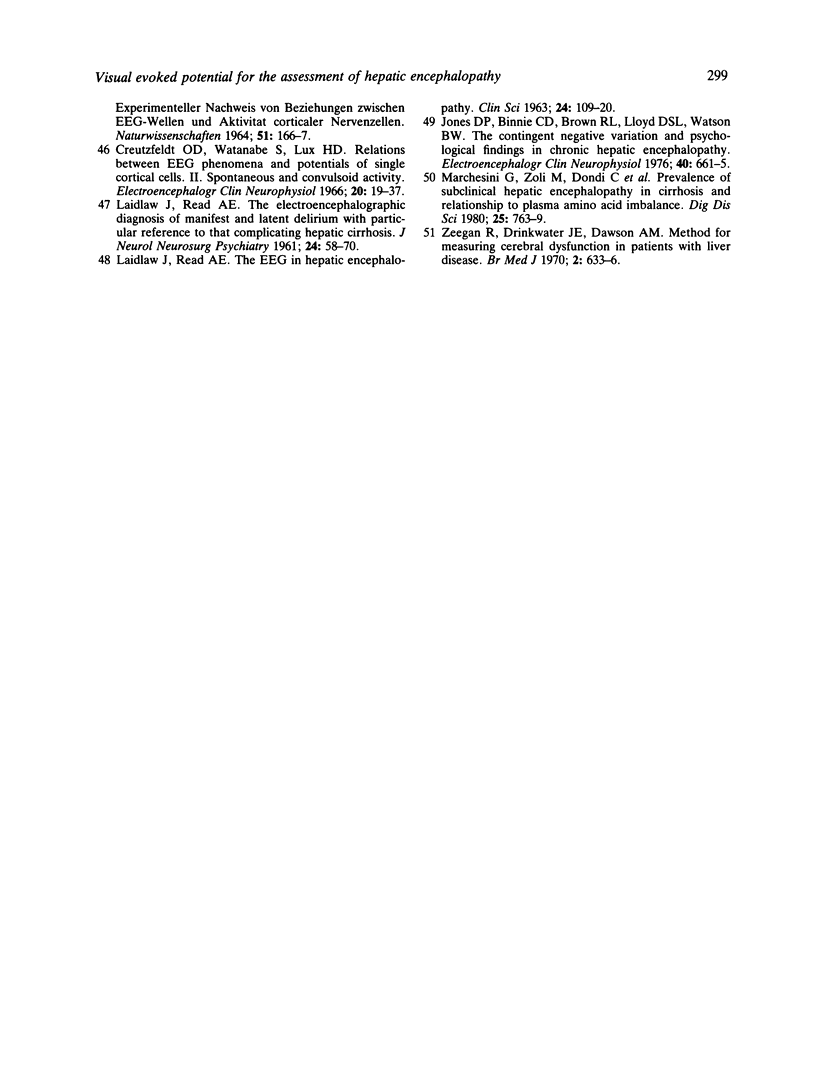
Selected References
These references are in PubMed. This may not be the complete list of references from this article.
- ADAMS R. D., FOLEY J. M. The neurological disorder associated with liver disease. Res Publ Assoc Res Nerv Ment Dis. 1953;32:198–237. [PubMed] [Google Scholar]
- AXELROD J. Purification and properties of phenylethanolamine-N-methyl transferase. J Biol Chem. 1962 May;237:1657–1660. [PubMed] [Google Scholar]
- Bergamini L., Bergamasco B. Possibility of the clinical use of sensory evoked potentials transcranially recorded in man. Electroencephalogr Clin Neurophysiol. 1967;(Suppl):114+–114+. [PubMed] [Google Scholar]
- Bodis-Wollner I., Onofrj M. System diseases and visual evoked potential diagnosis in neurology: changes due to synaptic malfunction. Ann N Y Acad Sci. 1982;388:327–348. doi: 10.1111/j.1749-6632.1982.tb50800.x. [DOI] [PubMed] [Google Scholar]
- Bodis-Wollner I., Yahr M. D. Measurements of visual evoked potentials in Parkinson's disease. Brain. 1978 Dec;101(4):661–671. doi: 10.1093/brain/101.4.661. [DOI] [PubMed] [Google Scholar]
- Carroll W. M., Kriss A., Baraitser M., Barrett G., Halliday A. M. The incidence and nature of visual pathway involvement in Friedreich's ataxia. A clinical and visual evoked potential study of 22 patients. Brain. 1980 Jun;103(2):413–434. doi: 10.1093/brain/103.2.413. [DOI] [PubMed] [Google Scholar]
- Cascino A., Cangiano C., Calcaterra V., Rossi-Fanelli F., Capocaccia L. Plasma amino acids imbalance in patients with liver disease. Am J Dig Dis. 1978 Jul;23(7):591–598. doi: 10.1007/BF01072593. [DOI] [PubMed] [Google Scholar]
- Chiappa K. H., Ropper A. H. Evoked potentials in clinical medicine (first of two parts). N Engl J Med. 1982 May 13;306(19):1140–1150. doi: 10.1056/NEJM198205133061904. [DOI] [PubMed] [Google Scholar]
- Conn H. O., Leevy C. M., Vlahcevic Z. R., Rodgers J. B., Maddrey W. C., Seeff L., Levy L. L. Comparison of lactulose and neomycin in the treatment of chronic portal-systemic encephalopathy. A double blind controlled trial. Gastroenterology. 1977 Apr;72(4 Pt 1):573–583. [PubMed] [Google Scholar]
- Corletto F., Gentilomo A., Rosadini A., Rossi G. F., Zattoni J. Visual evoked responses during sleep in man. Electroencephalogr Clin Neurophysiol. 1967;(Suppl):61–69. [PubMed] [Google Scholar]
- Creutzfeldt O. D., Watanabe S., Lux H. D. Relations between EEG phenomena and potentials of single cortical cells. II. Spontaneous and convulsoid activity. Electroencephalogr Clin Neurophysiol. 1966 Jan;20(1):19–37. doi: 10.1016/0013-4694(66)90137-4. [DOI] [PubMed] [Google Scholar]
- DAWSON G. D. A summation technique for the detection of small evoked potentials. Electroencephalogr Clin Neurophysiol. 1954 Feb;6(1):65–84. doi: 10.1016/0013-4694(54)90007-3. [DOI] [PubMed] [Google Scholar]
- Denckla W. D., Dewey H. K. The determination of tryptophan in plasma, liver, and urine. J Lab Clin Med. 1967 Jan;69(1):160–169. [PubMed] [Google Scholar]
- Elsass P., Christensen S. E., Ranek L., Theilgaard A., Tygstrup N. Continuous reaction time in patients with hepatic encephalopathy. A quantitative measure of changes in consciousness. Scand J Gastroenterol. 1981 Apr;16(3):441–447. doi: 10.3109/00365528109181995. [DOI] [PubMed] [Google Scholar]
- Fiaccadori F., Ghinelli F., Pelosi G., Sacchini D., Vaona G. L., Zeneroli M. L., Rocchi E., Santunione V., Gibertini P., Ventura E. Selective amono acid solutions in hepatic encephalopathy treatment (a preliminary report). Ric Clin Lab. 1980 Apr-Jun;10(2):411–422. [PubMed] [Google Scholar]
- Halliday A. M., McDonald W. I., Mushin J. Delayed pattern-evoked responses in optic neuritis in relation to visual acuity. Trans Ophthalmol Soc U K. 1973;93(0):315–324. [PubMed] [Google Scholar]
- Halliday A. M., McDonald W. I., Mushin J. Delayed visual evoked response in optic neuritis. Lancet. 1972 May 6;1(7758):982–985. doi: 10.1016/s0140-6736(72)91155-5. [DOI] [PubMed] [Google Scholar]
- Halliday A. M., McDonald W. I., Mushin J. Visual evoked response in diagnosis of multiple sclerosis. Br Med J. 1973 Dec 15;4(5893):661–664. doi: 10.1136/bmj.4.5893.661. [DOI] [PMC free article] [PubMed] [Google Scholar]
- Hamel B., Bourne J. R., Ward J. W., Teschan P. E. Visually evoked cortical potentials in renal failure: transient potentials. Electroencephalogr Clin Neurophysiol. 1978 May;44(5):606–616. doi: 10.1016/0013-4694(78)90127-x. [DOI] [PubMed] [Google Scholar]
- Jones D. P., Binnie C. D., Bown R. L., Lloyd D. S., Watson B. W. The contingent negative variation and psychological findings in chronic hepatic encephalopathy. Electroencephalogr Clin Neurophysiol. 1976 Jun;40(6):661–665. doi: 10.1016/0013-4694(76)90141-3. [DOI] [PubMed] [Google Scholar]
- LAIDLAW J., READ A. E. The E.E.G. in hepatic encephalopathy. Clin Sci. 1963 Feb;24:109–120. [PubMed] [Google Scholar]
- LAIDLAW J., READ A. E. The electroencephalographic diagnosis of manifest and latent 'delirium' with particular reference to that complicating hepatic cirrhosis. J Neurol Neurosurg Psychiatry. 1961 Feb;24:58–70. doi: 10.1136/jnnp.24.1.58. [DOI] [PMC free article] [PubMed] [Google Scholar]
- Marchesini G., Zoli M., Dondi C., Cecchini L., Angiolini A., Bianchi F. B., Pisi E. Prevalence of subclinical hepatic encephalopathy in cirrhotics and relationship to plasma amino acid imbalance. Dig Dis Sci. 1980 Oct;25(10):763–768. doi: 10.1007/BF01345296. [DOI] [PubMed] [Google Scholar]
- McDonald W. I., Sears T. A. The effects of experimental demyelination on conduction in the central nervous system. Brain. 1970;93(3):583–598. doi: 10.1093/brain/93.3.583. [DOI] [PubMed] [Google Scholar]
- Milner B. A., Regan D., Heron J. R. Differential diagnosis of multiple sclerosis by visual evoked potential recording. Brain. 1974 Dec;97(4):755–772. doi: 10.1093/brain/97.1.755. [DOI] [PubMed] [Google Scholar]
- Morgan M. Y., Milsom J. P., Sherlock S. Plasma ratio of valine, leucine and isoleucine to phenylalanine and tyrosine in liver disease. Gut. 1978 Nov;19(11):1068–1073. doi: 10.1136/gut.19.11.1068. [DOI] [PMC free article] [PubMed] [Google Scholar]
- PARSONS-SMITH B. G., SUMMERSKILL W. H., DAWSON A. M., SHERLOCK S. The electroencephalograph in liver disease. Lancet. 1957 Nov 2;273(7001):867–871. doi: 10.1016/s0140-6736(57)90005-3. [DOI] [PubMed] [Google Scholar]
- Saavedra J. M. Enzymatic-isotopic method for octopamine at the picogram level. Anal Biochem. 1974 Jun;59(2):628–633. doi: 10.1016/0003-2697(74)90316-9. [DOI] [PubMed] [Google Scholar]
- Zeegen R., Drinkwater J. E., Dawson A. M. Method for measuring cerebral dysfunction in patients with liver disease. Br Med J. 1970 Jun 13;2(5710):633–636. doi: 10.1136/bmj.2.5710.633. [DOI] [PMC free article] [PubMed] [Google Scholar]
- Zeegen R., Drinkwater J. E., Dawson A. M. Method for measuring cerebral dysfunction in patients with liver disease. Br Med J. 1970 Jun 13;2(5710):633–636. doi: 10.1136/bmj.2.5710.633. [DOI] [PMC free article] [PubMed] [Google Scholar]
- Zeneroli M. L., Penne A., Parrinello G., Cremonini C., Ventura E. Comparative evaluation of visual evoked potentials in experimental hepatic encephalopathy and in pharmacologically induced coma-like states in rat. Life Sci. 1981 Mar 30;28(13):1507–1515. doi: 10.1016/0024-3205(81)90383-0. [DOI] [PubMed] [Google Scholar]
- Zeneroli M. L., Ventura E., Baraldi M., Penne A., Messori E., Zieve L. Visual evoked potentials in encephalopathy induced by galactosamine, ammonia, dimethyldisulfide, and octanoic acid. Hepatology. 1982 Sep-Oct;2(5):532–538. doi: 10.1002/hep.1840020504. [DOI] [PubMed] [Google Scholar]
- Zieve L. Hepatic encephalopathy: summary of present knowledge with an elaboration on recent developments. Prog Liver Dis. 1979;6:327–341. [PubMed] [Google Scholar]
- da Fonseca-Wollheim F. Bedeutung von Wasserstoffionenkonzentration und ADP-Zusatz bei der Ammoniakbestimmung mit Glutamatdehydrogenase. Verkesserter enzymatischer Ammoniaktest, I. Mitteilung. Z Klin Chem Klin Biochem. 1973 Oct;11(10):421–425. [PubMed] [Google Scholar]


